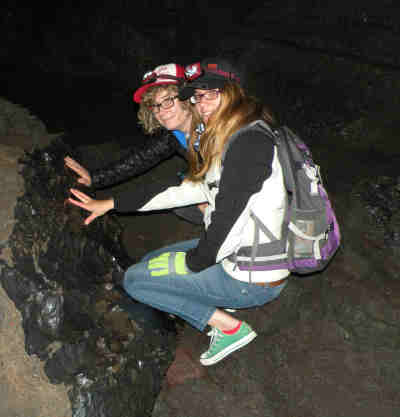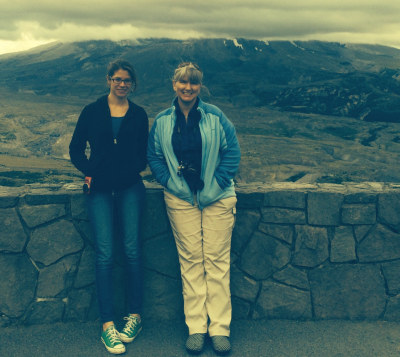EPIC Intern Winds Up Summer With "Ultrasound" of Mt. St. Helens
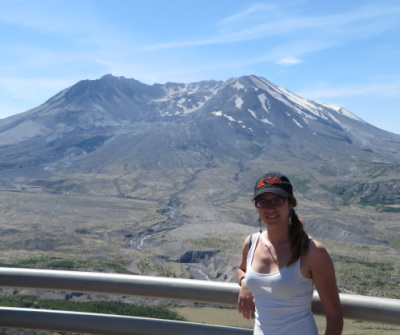 Federica Lanza, a Ph.D. student at Michigan Technological University under Gregory P. Waite, spent the summer as the EarthScope/EPIC intern. During that time, "Fede" deployed instruments with EarthScope interns, presented her work at the 2014 EarthScope workshop, and completed two research projects related to short period sensor responses and long period noise analysis using PSD PDFs. Fede wrapped up her summer with a couple of weeks in the field at Mt. St. Helens, supporting the iMUSH project, along with several other EarthScope/EPIC scientists and staff. Some highlights of our intern's busy summer follow.
Federica Lanza, a Ph.D. student at Michigan Technological University under Gregory P. Waite, spent the summer as the EarthScope/EPIC intern. During that time, "Fede" deployed instruments with EarthScope interns, presented her work at the 2014 EarthScope workshop, and completed two research projects related to short period sensor responses and long period noise analysis using PSD PDFs. Fede wrapped up her summer with a couple of weeks in the field at Mt. St. Helens, supporting the iMUSH project, along with several other EarthScope/EPIC scientists and staff. Some highlights of our intern's busy summer follow.
|
Fede's summer got off to a rousing start with the Interns Broadband Deployment (2014 IBD) in late May. On this shot, Fede (at right) was making a final check on the team's broadband station, just north of the EarthScope/EPIC. |
 |
 |
Fede (top right) and her fellow interns are shown celebrating their successful broadband seismometer deployment. |
|
In addition to the broadband deployment, the interns participated in an active-source refraction survey along the Socorro Fault a few miles south of the city (2014 IAS). EPIC's PEG (Propelled Energy Generator) was utilized as the active source for the survey. |
 |
 |
Fede and survey participants (including Rob Anthony of Colorado State University, and Greg Chavez of EarthScope/EPIC, along with several other interns at right) posed for a photograph following the refraction survey. |
|
On June 5, 2014, Fede presented her poster on "Spatial aliasing and source mechanism resolution: an example from Pacaya volcano, Guatemala" to EPIC staff. |
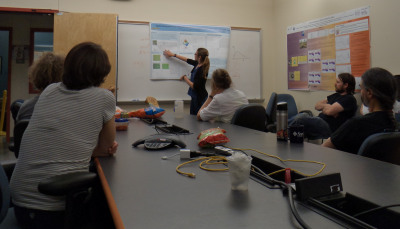 |
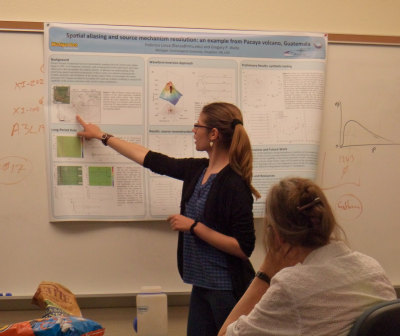 |
Fede's discussion was a dry run for her presentation at this summer's 2014 EarthScope Workshop, June 8-11, in Sunriver, Oregon. You can peruse Fede's work and that of other EarthScope/EPIC staff here. |
|
The summer was not all work for Fede. On June 15th, she took in Socorro's active local music scene at Roon's CD release party at the Capitol Bar. At right, Fede is seated with New Mexico Tech graduate students Stas Edel and Daisy Morgan, who performed as "Audio Frenzy" at the party. In the foreground is Martha Cather of New Mexico Tech's Petroleum Recovery Research Center (PRRC); Martha and her NMT geologist husband Steve also played music at the event. |
 |
 |
On June 27th, Fede attended the "Remembering Jim Fowler" event at the EarthScope/EPIC. Click on the image for a panoramic view of the audience as they listened to Tim Ahern of EarthScope on working with Jim Fowler. |
|
As the summer drew to a close, Fede joined several EarthScope/EPIC staff scientists at the iMUSH deployment at Mt. St. Helens. The project is described in detail in this July 8th article in Nature. |
 |
|
At right, Fede is shown working at the field instrument center in Castle Rock (WA). The team was just about to start programming the single-channel "Texan" digitizers for the first deployment, after having setting up the stations in the high school music room. |
 |
 |
The field centers for the Mt. St. Helens project were located at Woodland Intermediate School (southwest of Mt. St. Helens) and Castle Rock High School (several miles to the west of the volcano). Here, Fede helped install ~2500 batteries in 1200 Texans. The boxes in the background are filled with 15 Texans each, waiting to be loaded with batteries. |
|
Fede got the chance to inspect a normal fault scarp caused by one of the seismic shots. She reported that seeing a very fresh rupture surface was "pretty impressive." |
 |
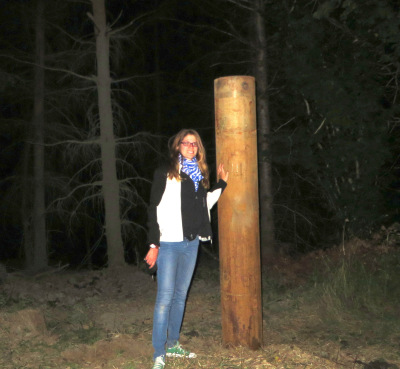 |
No Active Source experiment is really complete without experiencing the thump of a large explosive charge from a nearby location. The pipe shown at left was used for a seismic shot consisting of 2000 pounds of explosives. Fede and other team members felt Rayleigh waves very distinctly, and the pipe was raised from the ground by approximately 1-2 meters. Several cracks appeared in the ground around the pipe. |
|
The iMUSH project was featured on the front page of The Daily News on July 23rd, 2014. At right, Fede and EarthScope/EPIC staff scientist Katyliz Anderson are shown in the background of a closeup of Texans pending deployment. (These images from the Daily News were taken by photographer Roger Werth, and are used with permission. They are not to be used elsewhere without permission from The Daily News and Roger Werth.) |
 |
|
|
During breaks in the lengthy deployment, Fede and EPIC's Katyliz Anderson got a chance to check out Ape Caves, a Mt. St. Helens lava tube. |
|
|
|
|
|
Fede's first project at EPIC, in cooperation with the sensor group, was titled "Determining short-period sensor responses: lessons learned from Malargue, Argentina." In 2012, a large temporary seismic array was installed in the Malargue region, Mendoza, Argentina in an effort to (1) image the subsurface below the Malargue plain using ambient seismic noise sources, and (2) to monitor the local seismicity at the newly re-activated Planchon-Peteroa Volcano for hazard assessment purposes. The array consisted of 38 seismic stations: 37 L22s and 1 CMG40T. The main objectives of Fede's project were to analyze the L22 sensor response characteristics (frequency, damping, and sensitivity) using the Bird Dog II System to highlight the state of health of the sensors before, during, and after the experiment. (Download PDF - 9MB) Fede's second project looked at Long Period Noise Analysis of Power Spectral Density Functions (PSD) PDFs in Sweetwater, TX, USA. In March 2014, as a result of a collaborative effort between Nodal Seismic, Nanometrics, and EarthScope/EPIC, a temporary network of 20 Trillium Compact Post-hole sensors (20 sec) and 5 Trillium 120 Post-hole sensors were deployed ~20 km north of Sweetwater, Texas (see image at left). One of the main objectives of the experiment were to characterize noise fields in order to optimize station locations, instrument performances, emplacement methodologies, and to improve imaging applications. PSD PDFs were analyzed in order to identify station quality issues and to estimate the variation of noise at a given station. Seismic noise can be the result of the instrument itself (self-noise) or it can be produced from ambient Earth vibrations. In this study, the focus was on long-period noise (> 10 sec) over the entire installation period. (Download PDF - 42 MB) |
|
At right: Fede and EPIC's Mouse Reusch taking in one of the amazing vistas at Mt. St. Helens. |
|
|
|
Lava Canyon Selfies: this shot captured Fede and EPIC Data Group members Katyliz Anderson and Mouse Reusch posing in front of a waterfall at Lava Canyon in the Mt. St. Helens area. |
|
On August 7th, EarthScope/EPIC staff organized a farewell party for Fede. We wish her the best of luck in her third year of graduate studies at Michigan Tech! |
|
- Home
- General Information
- Instrumentation
- Dataloggers
- Sensors
- All-In-One Systems
- Power Systems
- Field Procedures
- Controlled Sources
- Seismic Source Facility
- Magnetotelluric Systems at EPIC
- Ground Penetrating Radar
- GNSS/GPS Receivers
- Power and Memory Calculations Form
- Data Archiving
- Apply for a PI Account
- Experiment Scheduling
- Polar
- Hardware & Software Notes
- Software

